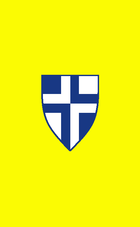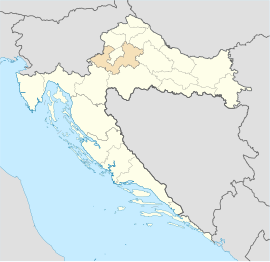Zaprešić
| Zaprešić | |||
|
|||
|
|
|||
| Basic data | |||
|---|---|---|---|
| State : |
|
||
| County : |
|
||
| Height : | 128 m. i. J. | ||
| Area : | 52.6 km² | ||
| Residents : | 25,223 (2011) | ||
| Population density : | 480 inhabitants per km² | ||
| Telephone code : | (+385) 01 | ||
| Postal code : | 10 290 | ||
| License plate : | ZG | ||
| Structure and administration (status: 2013, cf. ) |
|||
| Community type : | city | ||
| Mayor : | Željko Turk ( HDZ ) | ||
| Postal address : | Nova Ulica 10 10 290 Zaprešić |
||
| Website : | |||
Zaprešić is a city in Croatia . It is located in the County of Zagreb 17 km away from Zagreb away and has 25,223 inhabitants (census 2011 ).
geography
With 25,223 inhabitants (2011), Zaprešić is the third largest city in the Zagreb County . The urban area extends over an area of 52.6 km². With 480 inhabitants per km² it is the most densely populated place in the county (in comparison, the average population density in the Zagreb county is about 101 per km²). The wider area, which belongs to the city and seven other municipalities in the vicinity - Bistra , Brdovec , Dubravica , Jakovlje , Luka , Marija Gorica and Pušća - extends over an area of 251.8 km². According to the 2001 census, 50,992 people live there. The area around Zaprešić is located in the valley of three rivers . To the west of it is Slovenia , to the north is the Krapina-Zagorje County , to the south Samobor and Zagreb to the east.
- Rivers: Sutla in the west, Save in the south, Krapina in the east
- Mountain parts : Medvednica in the east, Marijagoričko Pobrđe in the northwest
- Nature reserves : Sava ornithological reserve in the town of Zaprešić and in the municipality of Brdovec, the botanical reserve of Cret Dubravica in the municipality of Dubravica, Medvednica nature park in the area of the town and the municipalities of Bistra and Jakovlje
history
The city was first mentioned in writing in connection with the Church of St. Peter, which was built in 1334.
First evidence of the early settlement of the Zaprešić area is provided by prehistoric finds from Brdovec, Marija Gorica and traces of settlement from the Iron Age in the municipality of Sv. Križ.
Other remains from ancient times can be found in Brdovec. In the Roman Empire , the road Emona ( Ljubljana ) - Neviodunum (today's village Drnovo near Krško in Slovenia up to which the Sava was navigable) - Siscia ( Sisak ) ran here. Furthermore, there was a crossing over the Sava in the municipality of Brdovec, over which the local road next to the Sutla connected with the Emona-Siscia road.
At the end of the 11th century (around 1094) Ača, the confidante of the King of Hungary Ladislaus I , received the area east and west of the Medvednica from him. This property, which later developed into a county , began on the western limits of the mountains and extended from the Save to the Sutla.
During the 15th-16th In the 19th century, many immigrants fled from the Ottoman troops. Their descendants preserved the typical ikavic dialect (icavica), which is still taught today in primary schools in the city.
In 1573 the serfs rose up in a peasant revolt . One of their leaders was Ilija Gregorić from Marija Gorica. At the end of the 16th century, several small counties formed in the region and in the 17th and 18th centuries. In the 19th century, the smaller nobility lived there . Structures that are reminiscent of this time are simple castles , built on ten smaller pieces of land. Some of them have survived to this day.
Zaprešić became an important hub for both regional and international traffic. The first railway line in Croatia ran through Zaprešić. According to some theories, merchants used to pull their horse-drawn carts ("zaprega") through the city to get to Zagreb, hence the name Zaprešić.
On November 30, 1995, the city council formed today's city of Zaprešić at a meeting. The following places belong to the city of Zaprešić from this point on: Zaprešić, Ivanec, Jablanovec, Hruševec Kupljenski, Kupljenovo, Pojatno and Šibice. A day to honor the city is set on October 16, the birthday of Ban Josip Jelačić .
Economy and Transport
Important economic sectors in and around Zaprešić are the ceramic , chemical , metal , food and pharmaceutical industries as well as tourism . There are also production facilities for the manufacture of track structures ( rails , switches ) and technical gas .
Zaprešić is located on the regional main road and on the international railway line between Zagreb and Ljubljana.
Attractions
In the area around the city there are some well-known preserved castles that were built in the 18th and 19th centuries. Century originated. Two of them fall into a very special category: On the one hand, the Baroque Oršić Castle in Gornja Bistra (part of the municipality of Bistra), and on the other, the Januševec Castle in Brdovec, which some writers consider the most beautiful monument of classical architecture in Croatia. There is also the Lužnica Castle near Šibice (Zaprešić), Laduč (Brdovec) and Novi Dvori in Zaprešić. In addition to the many castles, there are residences of the earlier counts, churches and typical houses from the Hrvatsko Zagorje region (traditional buildings from Dubravica, painted blue on the facades ).
Novi Dvori
The early baroque Novi Dvori Castle (in German: "New Courtyards") is a unique example, as the entire complex of the manor house of around 20.5 hectares , including the castle itself; the chapel of St. Joseph, gardens, farm buildings and the grave of the Jelačić family have been preserved. It is believed that the foundation stone for the castle, also known as Curia Nova in Latin, was laid in 1611. At first it belonged to the count family Zrinski, then the counts Čikulina, Sermagea, Festetića and Erdodya. In 1851, Ban Josip Jelačić bought Novi Dvori from the then owner Count Aleksander Erdodya for 175,000 forints and had it completely redesigned. From 1863 the castle was owned by the brother desure Jelačić. After the death of his daughter Countess Anke Jelačić in 1934, the Croatian cultural association Matica hrvatska took over the administration. In the time of the NDH from 1941 to 1945 it was the residence of the leader of the National Socialist , fascist Ustaše movement, Ante Pavelić . From 1945 to 1956 there was a school for housekeeping and agriculture in the castle , later only for agriculture and a boarding school . But this operation was also closed in 1970. Today the “Matija skurjeni” museum as well as a golf course are part of the Novi Dvori complex.
Sports
One of the many sports clubs in Zaprešić is the local football club NK Inter Zaprešić , which is one of the founding members of the 1st HNL , the first Croatian league. The club mostly commutes between the first and second Croatian football league .
Personalities
- Baltazar Adam Krčelić (1715–1778), doctor of philosophy and theology, lawyer, rector of the Croatian body in Vienna, chronicler, historian and writer
- Pavao Štoos (1806–1862), poet
- Ante Kovačić, (1854–1889), writer, poet
- Ivan Perkovac (1826–1871), writer, newspaper editor
- Before that, Gobac, singer
- Matija Skurjeni (1898–1990), painter
- Joseph Jelačić von Bužim (1801-1859), Croatian Ban (appointed 1848)
- Mira Vlahović, opera singer
- Before that Vuković, painter
Web links





